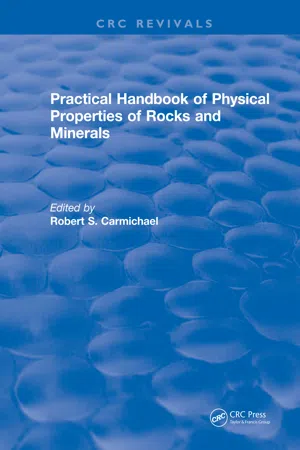Physics
Density
Density refers to the measure of mass per unit volume of a substance. It is a fundamental property of matter and is often denoted by the symbol "ρ." The density of a material determines its buoyancy in a fluid and is a crucial factor in various scientific and engineering applications.
Written by Perlego with AI-assistance
Related key terms
Related key terms
1 of 4
Related key terms
1 of 3
6 Key excerpts on "Density"
- Robert S. Carmichael(Author)
- 2017(Publication Date)
- CRC Press(Publisher)
Section IIDensities of Rocks and Minerals ByGary R. Olhoeft and Gordon R. JohnsonConcepts
Density is a physical property that changes significantly among various rock types owing to differences in mineralogy and porosity. If the distribution of underground rock densities is known, potentially much information can be learned about subsurface geology. Laboratory or borehole measurements of Density can thus aid in the interpretation of field studies and, especially, gravity surveys.In common usage, Density is defined as the weight in air of a unit volume of an object at a specific temperature; however, in strict usage, the Density of an object is defined as mass per unit volume. Weight is defined as the force that gravitation exerts on a body and thus varies with location, whereas mass is a fundamental property, a measure of the matter in a body; and mass is constant irrespective of geographic location, altitude, or barometric pressure. In many instances, such as routine Density measurements of rocks, the sample weights are considered to be equivalent to their masses because the discrepancy between weight and mass will result in less error in the computed Density than will experimental errors encountered in the measurement of volume. Therefore, Density is often determined using weight rather than mass. Moreover, when using an equal-arm balance and standard masses to weigh an object, the effects of variations in the force of gravity are negated. The resultant measurement of apparent mass differs slightly from true mass due to the buoyant effects of air. True mass, if desired, can be computed by using a correction for the buoyant effects of air.Specific gravity, in contrast to Density, is defined as the ratio of the weight or mass in air of a unit volume of material at a stated temperature to the weight or mass in air of a unit volume gas-free distilled water at a stated temperature. Density should be reported in SI units (kg/m3 ) but often is reported as g/cm3 . Specific gravity is dimensionless. Measurements of weight and volume are usually made in laboratories where normally minor variations of ambient temperature in the same laboratory as well as among laboratories have little effect on densities of rocks and minerals. For this reason the temperature at which Density or specific gravity is determined is often ignored, and densities are thus commonly reported without regard to temperature. However, according to Mason,1 ignoring the effect of temperature on determinations of Density can lead to errors that are greater than the experimental error encountered while making careful routine measurements. Mason1 discussed the concept of Density in relation to temperature, errors to expect from misunderstanding of the effects of temperature, and how to apply corrections in order to minimize errors. For the sake of clarity, the expression for Density should be “Density at x” where x is the temperature of the material. The usage of the terms Density and specific gravity are standardized in a few publications such as International Society for Rock Mechanics Committee on Laboratory Tests, Document number 2,2 and ASTM E12-70.3- eBook - ePub
- Thomas Hughes(Author)
- 2014(Publication Date)
- International Society of Automation(Publisher)
9
Liquid Density Measurement
Introduction
This chapter discusses the basic principles of liquid Density and specific gravity measurements. Control of the more common variables, such as flow, temperature, level, and pressure, is the basic criterion for process control. However, there are cases where measuring Density or specific gravity (SG) is the best way to determine and control the concentration of a process solution.Density, ρ , is defined as the mass per unit volume. The Density of a homogeneous fluid may depend on many factors, such as its temperature and the pressure to which it is subjected. Most liquids are only slightly compressible, and pressure effects in Density and specific gravity control applications are normally neglected. The Density of a liquid is an important characteristic that is often used to determine properties like concentration, composition, and the BTU content of some fuels, and for liquid flow and volumetric applications.Density Units and Definitions
Relative Density, or specific gravity, is defined as the ratio of the Density of a fluid to that of water at a given temperature. Since specific gravity is a ratio, it has no associated units. Both Density and specific gravity express the same physical property of a material and they are only meaningful if defined at a given temperature. In the case of specific gravity, the temperature can be different for the process material and the reference liquid. This is permissible but the different temperatures must be clearly stated. A specific gravity table, for instance, might list a process fluid as having a specific gravity of 0.9580/40 . This indicates that the process fluid at 80°F (27°C) will have a Density of 0.95 times that of water at 40°F (4.4°C).Since Density is expressed as mass per unit volume, these units must be listed with the process data. Commonly used Density units are grams per cubic centimeter (g/cm3 ), kilograms per cubic meter (kg/m3 ) and pounds per cubic foot (lbs/ft3 - eBook - ePub
Forest Products and Wood Science
An Introduction
- Rubin Shmulsky, P. David Jones(Authors)
- 2018(Publication Date)
- Wiley-Blackwell(Publisher)
A piece of sugar pine with a Density of 380 kg m −3 dry wood substance m −3 includes about 25% cell wall material and 75% voids (principally lumen space) by volume. In contrast, white oak with a Density of 750 kg dry wood substance m −3 has a void volume of about 50%. When considering the Density of wood, it can be helpful to visualize the void volume to which it corresponds. It is easy to see why a block containing 50% void volume will resist crushing to a much greater extent than a block with 75% void volume. The physicomechanical properties of wood are mainly determined by three characteristics: (i) the porosity or proportion of void volume, which can be estimated by measuring the Density; (ii) the organization of the cell structure, which includes the microstructure of the cell walls and the variety and proportion of cell types (the organization of the cell structure is principally a function of species); and (iii) the moisture content. The effect of bound water on the properties of wood was discussed in Chapter 7. In the engineering and use of wood materials, it is important to keep these three characteristics in mind. Density and specific gravity are the two physical properties commonly used to describe the mass of a material per unit volume. These properties are commonly used in connection with all types of materials. Density (D) is defined as the mass or weight per unit of volume. It is usually expressed in kilograms per cubic meter (kg m −3), grams per cubic centimeter (g cm −3), or pounds per cubic foot (lb ft −3). A word of caution is in order when discussing wood Density. There is no universally accepted procedure for calculating the Density of wood. For instance, although Density is frequently expressed in terms of green weight and green volume when calculating weights for transportation or construction, this is not always the case. It is, therefore, important to be sure of the basis of the calculation when discussing wood Density - eBook - ePub
Environmental Fluid Dynamics
Flow Processes, Scaling, Equations of Motion, and Solutions to Environmental Flows
- Jorg Imberger(Author)
- 2012(Publication Date)
- Academic Press(Publisher)
−8 m for a liquid, the mean properties of the molecules do not change. Continuum mechanics thus deals only with the average properties of the molecules and assigns these mean values to the centroid of the averaging volume; these mean properties are well-defined for any averaging volume greater than a few molecular spacing and less than 1 mm. All conservation equations in continuum mechanics deal only with these mean properties and there is no attempt made to derive equations for each molecule and then average; as we shall see the conservation equations are derived, from first principles, for the average properties and applied to volumes larger than 1 mm; such volumes are called fluid particles. It is important to visualize such a fluid particle. It is a collection of molecules over which we average all properties at a particular point in space and at a particular time. However, as time varies, the molecules will not always be the same; molecules continuously escape and enter the fluid particle. In this way, neighboring fluid particles transfer their properties to their neighbors; molecules escaping from a fluid particle with a large momentum into a fluid particle with less mean momentum will cause the slower particle to accelerate; this is the origin of internal friction. Similarly, molecules in a fluid particle at high temperature will have a high level of excitation; when they escape and move into a neighbor with a lower temperature, they will excite the molecules in their new environment and so raise the temperature of the neighbor. This is called diffusion of heat.1.3.4 Mass of a Fluid
Density ρ : In line with the continuum hypothesis defined above, the Density ρ of a fluid is given by:(1.3.3)where the limit is taken to between 1 mm and 10−5 mm. This Density may change from point to point or even with time and in general:(1.3.4)Once the Density is defined it is convenient to form specific definitions for related properties that are often encountered in environmental flows.Specific weight γ (N m−3 ):(1.3.5)Specific gravity s :(1.3.6)Sigma t σt(kg m−3 ):(1.3.7)Specific volume υ (m3 kg−1 ):(1.3.8)1.3.5 Pressure and Compressibility
Consider a fluid sample inside a press where a piston exerts a pressure on the fluid sample. The pressure p exerted by the piston is defined as the force per unit area (F /A ). The units of pressure are N m−2 or Pascals. The fluid may be compressed while keeping the temperature constant (isothermal compression) by extracting any excess heat, or the container may be insulated and heat prevented from escaping (adiabatic compression); two pressure volume curves result because during adiabatic compression the temperature of the fluid rises and, as it does, so does the pressure.From common experience, we know that gases are more compressible than liquids; the reason for this lies in the greater molecular spacing in gases. Hence the pressure rises much faster in liquids for the same compression ratio as for gases. The ease with which a fluid may be compressed is quantified by the compressibility of the fluid. The bulk coefficient of compressibility of a fluid,Eυ, is defined as the change in pressure for a unit fractional volume change curves:(1.3.9)and soEυhas units of pressure. ObviouslyEυwill have a different value depending whether the volume changes are brought about under isothermal or adiabatic conditions; typical values for isothermal compression for water are shown in Table 1.3.1 - eBook - ePub
Hegel's Philosophy of Nature
Volume II Edited by M J Petry
- G W F Hegel(Author)
- 2014(Publication Date)
- Routledge(Publisher)
10 of its mass. Physics attempts to explain Density in its own way, by assuming certain propositions, i.e. (1) That given an equal number of material parts of equal size, there will be no difference in weight. From this it follows (2) that it is the measure of the number of parts which determines 15 the weight. It also determines the space, so that (3) two entities of equal weight also fill the same amount of space. Consequently, (4) when two entities of equal weight have different volumes the amount of space they occupy as materials is the same, and their difference is assumed to be 20 the result of their pores. The first three propositions make it necessary to postulate the pores in the fourth. These propositions are not based upon experience however, they are based merely upon the understanding and its proposition of identity. They are therefore formal apriori inventions, as the pores are. Kant has 25 already opposed intensity to the quantitative determination of amount, and posited a constant number of parts with a higher propensity for filling space, instead of more parts in an equal volume. In this way he has initiated a so-called dynamic physics. The determination of intensive quantum + would be just as valid as that of extensive quantum, although the popular conception of Density mentioned above has confined itself to the latter category. In this instance however, the determination of intensive magnitude has the advantage of implying measure, and above all of indicating a being-in-self 35 which in its Notional determination is immanent determinateness of form, and which only appears, by means of comparison, as a general quantum. Dynamic physics gets no further than regarding these differences as extensive or intensive, and so fails to express any reality (§ 103 Rem.). 40 - eBook - ePub
- Atef Korchef(Author)
- 2022(Publication Date)
- CRC Press(Publisher)
- 7. c
- 8. b
- 9. c
- 10. d
- 11. c
- 12. a
- 13. a
- 14. a
- 15. a
- 16. b
- Q2.4
- 1. c
- 2. b
- 3. d
- 4. c
- 5. a
- 6. a
- 7. c
- 8. a
- 9. d
- 10. b
- 11. a
- 12. d
- 13. d
- 14. b
- 15. d
- 16. b
- 17. a
- 18. c
- 19. d
- 20. a
- 21. c
- 22. a
- Q2.5
- 1. c
- 2. b
- 3. b
- 4. a
- 5. d
- 6. b
- 7. a
- 8. d
- 9. d
- 10. c
- 11. d
- 12. a
- 13. b
- 14. b
- 15. a
- 16. b
- 17. c
- 18. c
- 19. b
- 20. c
- 21. a
- 22. b
- 23. b
- 24. c
- 25. d
- 26. a
- 27. b
- 28. c
- 29. d
- 30. d
- Q2.6
- 1. The Density ρ = m/V = 80/ 8000 = 0.01 g cm−3 The Density in kg/m3 is ρ = m/V = 0.08 / 0.0080 = 10 kg m−3
- 2. When the cube is cut into two pieces, the Density does not change because Density is an intensive property (it does not depend on the amount of matter)
- Q2.7
- a. (3.234 – 0.067) × 2.05/ (1.0 + 1.2346) = 3.0
- b. 86 × 23 = 2.0 × 103
- c. (20.0 × 100.0) = 2.00 × 103
- d. 50.00 × 140.0 = 7.000 × 103
- e. (4.05 − 0.2 + 2.123) / (0.0501 × 0.40) = 3.0 × 102
Key Answer Explanations
- Q2.3
- 1. Temperature cannot be defined in terms of other fundamental physical quantities. Temperature is a fundamental quantity and its SI unit is K.
- 2. Density (ρ) is the ratio of mass (m) and volume (V) of a substance (ρ = m/V), so it can be defined in terms of the fundamental physical quantities mass and length (volume = length × length × length).
- 3. Volume (V) is a derived quantity (volume = length × length × length). It can be fully defined by magnitude only (without direction), so volume is a scalar quantity. The SI unit of volume is m3 .
- 4. Mass is a fundamental quantity, and its SI basic unit is kg.
- 5. Amount of substance is fundamental quantity, and its SI basic unit is mol.
- 6. Pressure is a derived quantity, and its SI unit is Pa.
- 7. Energy is a derived quantity, and its SI unit is J.
- 8. Length is a fundamental quantity, and its SI unit is m.
- 9. Time is a fundamental quantity, and its SI unit is s.
- 10. Concentration (C = n/V, where n is the number of moles of the substance and V is the volume) is a derived scalar quantity. Its SI unit is mol m−3 .
- 11. Temperature, mass and length are fundamental quantities. Pressure is a derived quantity.
Index pages curate the most relevant extracts from our library of academic textbooks. They’ve been created using an in-house natural language model (NLM), each adding context and meaning to key research topics.
Explore more topic indexes
Explore more topic indexes
1 of 6
Explore more topic indexes
1 of 4





